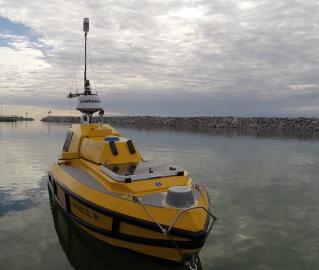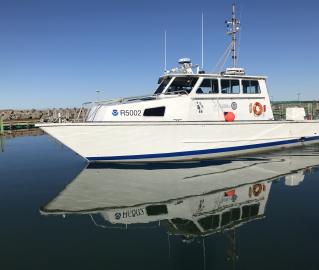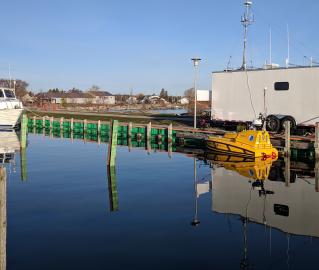Searching for Shipwrecks in Thunder Bay National Marine Sanctuary
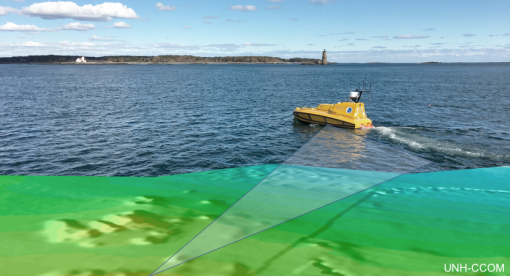
Alongside the 2019 E/V Nautilus expedition season, Ocean Exploration Trust (OET) is collaborating on an expedition from May 6-19, 2019 to explore the Great Lakes. This mission is focused on mapping unexplored, newly expanded areas of Thunder Bay National Marine Sanctuary (TBNMS) in Lake Huron, with a goal of discovering new shipwrecks and identifying shipwreck locations to support ongoing exploration and management.
Target areas will be mapped with a multibeam sonar system aboard autonomous surface vehicle ASV BEN from University of New Hampshire’s Center for Coastal and Ocean Mapping. The Research ASV BEN (Bathymetric Explorer and Navigator) is a 4 meter long vessel with diesel jet drive propulsion, a top speed of 5.5 knots and an endurance of about 16 hours. ASV BEN is equipped with state-of-the art seafloor mapping systems for hydrographic surveys, including a Kongsberg EM2040P multibeam swath mapping echosounder and an Applanix POS/MV inertially aided GPS navigation system. The Research Vessel R/V Storm, operated by NOAA Great Lakes Environmental Research Lab, and equipped with multibeam echo sounder technology provided by the National Marine Sanctuary Foundation, will be supporting the ASV and also conduct mapping and surveying in adjacent areas.
Co-lead Scientists Stephanie Gandulla, Jeff Gray, and Russ Green from Thunder Bay National Marine Sanctuary will be guiding research priorities, with ASV Team Leader Val Schmidt from UNH's Center for Coastal and Ocean Mapping and Expedition Leader Lindsay Gee, of Ocean Exploration Trust. Sponsored by NOAA Office of National Marine Sanctuaries, this project marks the first partnership between Thunder Bay National Marine Sanctuary and the Ocean Exploration Trust. However, OET’s President Dr. Robert Ballard led previous exploration projects in Lake Huron in 2001 and 2002, with the former Institute For Exploration.
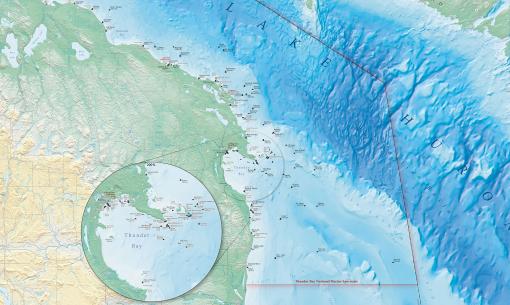
Underwater Archaeology of the Great Lakes
Located in Lake Huron, NOAA’s Thunder Bay National Marine Sanctuary was established in 2000 to protect one of the nation’s most historically significant collections of shipwrecks. In 2014, the sanctuary expanded from 448 to 4,300 square miles, making it the nation’s largest marine protected area focused on underwater cultural heritage sites. Within this new boundary are 99 known shipwreck sites, while historic research indicates as many 100 additional sites in the area remain undiscovered. TBNMS’ submerged archaeological sites are a nearly complete collection of Great Lakes vessel types, from small schooners and pioneer steamboats of the 1830s to massive industrial bulk carriers that supported America’s heavy industries during the 20th century.
Thunder Bay National Marine Sanctuary protects and manages this nationally significant collection of shipwrecks through an integrated program of research, resource protection, outreach, and education. This expedition will provide baseline information to support ongoing exploration and management of this important area of underwater cultural heritage sites. In addition, the bathymetry and backscatter data can be used in producing lake floor habitat maps for managing the condition of coastal Lake Huron’s ecosystems.
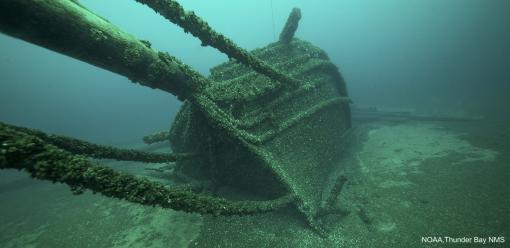
Surveying From Shallow Waters to “Shipwreck Alley”
Three targeted survey areas in northern Lake Huron embody the diverse and rich maritime cultural landscape of the Great Lakes, including a historic lighthouse on a treacherous reef; dangerous, near-shore shallow waters; and the deep, mid-lake waters of busy shipping lanes. Given the high-tech, experimental nature of ASV BEN, the team will be assessing and prioritizing these areas in real time during the project.
Spectacle Reef is an isolated natural obstruction to navigation located in northern Lake Huron. Its proximity to the Straits of Mackinac and the St. Mary's River places the reef at an important convergence of commercial shipping traffic for vessels operating on three of the five Great Lakes. Four historic vessels are known to have wrecked on the reef, the Kate Hayes (1856), Augustus Handy (1861), Asia (1866), and Nightingale (1869), prompting the federal government to construct a lighthouse there in 1870. Despite the aid to navigation, three additional wrecks occurred on the reef, the Newell A. Eddy (1893), Sea Gull (1893), and Richard G. Winslow (1898). Although the locations of most of these wrecks are known, their associated debris fields have never been mapped. Additionally, an airplane was lost near the reef in the early 1950s and has not yet been found.
A number of vessels are reported losses in Hammond Bay, a body of water known for inclement weather and groundings in shallow water. These include the wooden schooners Lady Franklin (1895) and Glad Tidings (1898), and the wooden steambarge John C. Liken, lost in 1890. Dynamic shorelines and shifting sands, characteristic of shallow water, make surveying this area vital to establishing baseline documentation to aid sanctuary management in regularly monitoring this particular environment and potential historic resources.
The third targeted survey environment represents the most potential for discovery of intact shipwrecks within the sanctuary. Dubbed “Shipwreck Alley,” the shipping lanes in northern Lake Huron are notorious for heavy vessel traffic and intense weather patterns. Despite the challenges of surveying in these waters, in 2017 TBNMS with partners University of Delaware and Michigan Technological University discovered and identified the wooden freighter Ohio, which suffered a fatal collision with the schooner Ironton. The Ironton has yet to be found, and remains an objective of this expedition.
In addition to the potential discovery of historically significant shipwrecks, sanctuary waters in Lake Huron also hold the potential for unique natural features such as sinkholes with links to ancient ecosystems, glacial features of interest, and important fish habitat.
Follow the Expedition
We will bring the excitement of this project to the public through social media, an event at NOAA’s Great Lakes Maritime Heritage Center, and ship-to-shore interactions with local schools and Nautilus.
Facebook Live events on NOAA Office of National Marine Sanctuaries Facebook page:
- Friday, May 10, at 3 p.m. Eastern: A behind-the-scenes tour of the Thunder Bay National Marine Sanctuary expedition and control van.
- Tuesday, May 14, between 4:30 and 6:30 p.m. Eastern: Meet the scientists!
- Thursday, May 16, at 11:30 a.m. Eastern: Meet the scientists!
Meet the expedition team and see ASV BEN at the Great Lakes Regional MATE ROV Competition on May 11 in Alpena, Michigan.
Follow the expedition partners for updates from the field:
Ocean Exploration Trust: Nautilus Live Expedition Page, Facebook, Twitter, Instagram
Thunder Bay National Marine Sanctuary: Website, Facebook, Twitter
NOAA’s Office of National Marine Sanctuaries: Website, Facebook, Twitter, Instagram
UNH Center for Coastal and Ocean Mapping: Website, Facebook, Twitter
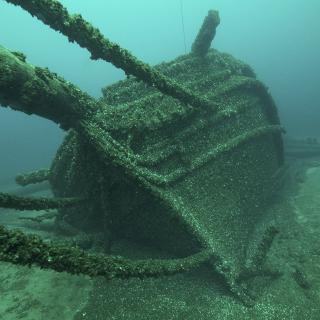
Thunder Bay National Marine Sanctuary
Alongside the E/V Nautilus expedition season, Ocean Exploration Trust is collaborating on an expedition to explore inland waterways of the Great Lakes. This mission is focused on mapping unexplored, newly expanded areas of Thunder Bay National Marine Sanctuary (TBNMS) in Lake Huron, with a goal of discovering new shipwrecks and identifying shipwreck locations to support ongoing exploration and management.
